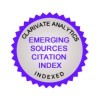Research Article
Review
Aim & Scope
Istanbul Business Research (IBR) is an international academic and peer-reviewed journal of Istanbul University Business School. The journal is a semi-annually, academic, peer reviewed journal which publishes articles in English. IBR aims high academic standards and welcomes high grade academic contributions from business scholars and professionals. It publishes novel, theoretical or research based studies along with studies with strong qualitative and quantitative analysis.
The journal is published twice a year and covers multi-disciplinary studies from business and economics field including but not limited to;
· Human Resources Management
· Decision sciences,
· Marketing,
· Production & Operations management,
· Finance
· Management & Strategy,
· Organization Theory
· Accounting
Author Guidelines
MANUSCRIPT ORGANIZATION
Language
The language of the journal is English.
Manuscript Organization and Submission
All correspondence will be sent to the first-named author unless otherwise specified. Manuscpript is to be submitted online via http://ibr.istanbul.edu.tr and it must be accompanied by a cover letter indicating that the manuscript is intended for publication, specifying the article category (i.e. research article, review etc.) and including information about the manuscript (see the Submission Checklist). Manuscripts should be prepared in Microsoft Word 2003 and upper versions. In addition, Copyright Agreement Form that has to be signed by all authors must be submitted.
1. The manuscripts should be in A4 paper standards: having 2.5 cm margins from right, left, bottom and top, Times New Roman font style in 12 font size and line spacing of 1.5.
2. The manuscripts should contain between 4500 and 8500 words and the page numbers must be at the bottom and in the middle.
3. The name(s) of author(s) should be given just beneath the title of the study aligned to the left. Also the affiliation, title, e-mail and phone of the author(s) must be indicated on the bottom of the page as a footnote marked with an asterisk (*).
4. Submitted manuscripts in English must have before the introduction section, the abstract in English, between 180 and 200 words, summarizing the scope, the purpose, the results of the study and the methodology used. Underneath the abstracts, 3 to 5 keywords that inform the reader about the content of the study should be specified in English.
5. The manuscripts should contain mainly these components: title, abstract and keywords; extended abstract, body text with sections, footnotes and references.
6. The 6th version of the APA (American Psychological Association) reference style should be used for in-text citation and references list. For information and samples on the APA 6 style please refer to http://ibr.istanbul.edu.tr/en/content/information-for-authors/references and/or REFERENCES section in the Information for Authors.
7. Tables, graphs and figures can be given with a number and a defining title if and only if it is necessary to follow the idea of the article. the article. The title of table should be placed above the table; caption of figure should be placed beneath the figure. Features like demographic characteristics that can be given within the text should not be indicated as tables separately.
8. Please submit tables as editable text and not as images. When preparing tables, please avoid using vertical rules and shading in tables cells. If you are using a table grid, use only one grid for each individual table and not a grid for each row. If no grid is used, use tabs, not spaces, to align columns.
9. It is important that the file be saved in the native format of the word processor used. You are strongly advised to use the "spell-check" and grammer-check" functions of your word processor to avoid unnecessary errors.
10. The text should be in single-column format. Keep the layout of the text as simple as possible.
11. A title page including author information must be submitted together with the manuscript. The title page is to include fully descriptive title of the manuscript and, affiliation, title, e-mail address, postal address, phone and fax number of the author(s) (see The Submission Checklist).
12. Authors are responsible for all statements made in their work submitted to the Journal for publication.
13. The author(s) can be asked to make some changes in their articles due to peer reviews.
14. A copy of the journal will be sent to each author of the accepted articles upon their request.
Figures and Figures Legends
Figures, graphics, and photographs should be submitted as separate files (in TIFF or JPEG format) through the submission system. The files should not be embedded in a Word document or the main document. When there are figure subunits, the subunits should not be merged to form a single image. Each subunit should be submitted separately through the submission system. Images should not be labeled (a, b, c, etc.) to indicate figure subunits. Thick and thin arrows, arrowheads, stars, asterisks, and similar marks can be used on the images to support figure legends. Like the rest of the submission, the figures too should be blind. Any information within the images that may indicate an individual or institution should be blinded. The minimum resolution of each submitted figure should be 300 DPI. To prevent delays in the evaluation process, all submitted figures should be clear in resolution and large in size (minimum dimensions: 100 × 100 mm). Figure legends should be listed at the end of the main document.
Tables
Tables should be included in the main document, presented after the reference list, and they should be numbered consecutively in the order they are referred to within the main text. A descriptive title must be placed above the tables. Abbreviations used in the tables should be defined below the tables by footnotes (even if they are defined within the main text). Tables should be created using the“insert table” command of the word processing software and they should be arranged clearly to provide easy reading. Data presented in the tables should not be a repetition of the data presented within the main text but should be supporting the main text.
Ethical Principles and Publication Policy
Publication Ethics and Malpractice Statement
Istanbul Business Research is committed to upholding the highest standards of publication ethics and pays regard to Principles of Transparency and Best Practice in Scholarly Publishing published by the Committee on Publication Ethics (COPE), the Directory of Open Access Journals (DOAJ), the Open Access Scholarly Publishers Association (OASPA), and the World Association of Medical Editors (WAME) on https://publicationethics.org/resources/guidelines-new/principles-transparency-and-best-practice-scholarly-publishing
All parties involved in the publishing process (Editors, Reviewers, Authors and Publishers) are expected to agree on the following ethical principles.
All submissions must be original, unpublished (including as full text in conference proceedings), and not under the review of any other publication synchronously. Each manuscript is reviewed by one of the editors and at least two referees under double-blind peer review process. Plagiarism, duplication, fraud authorship/denied authorship, research/data fabrication, salami slicing/salami publication, breaching of copyrights, prevailing conflict of interest are unnethical behaviors.
All manuscripts not in accordance with the accepted ethical standards will be removed from the publication. This also contains any possible malpractice discovered after the publication. In accordance with the code of conduct we will report any cases of suspected plagiarism or duplicate publishing.
Research Ethics
The journal adheres to the highest standards in research ethics and follows the principles of international research ethics as defined below. The authors are responsible for the compliance of the manuscripts with the ethical rules.
- Principles of integrity, quality and transparency should be sustained in designing the research, reviewing the design and conducting the research.
- The research team and participants should be fully informed about the aim, methods, possible uses and requirements of the research and risks of participation in research.
- The confidentiality of the information provided by the research participants and the confidentiality of the respondents should be ensured. The research should be designed to protect the autonomy and dignity of the participants.
- Research participants should participate in the research voluntarily, not under any coercion.
- Any possible harm to participants must be avoided. The research should be planned in such a way that the participants are not at risk.
- The independence of research must be clear; and any conflict of interest or must be disclosed.
- In experimental studies with human subjects, written informed consent of the participants who decide to participate in the research must be obtained. In the case of children and those under wardship or with confirmed insanity, legal custodian’s assent must be obtained.
- If the study is to be carried out in any institution or organization, approval must be obtained from this institution or organization.
- In studies with human subject, it must be noted in the method’s section of the manuscript that the informed consent of the participants and ethics committee approval from the institution where the study has been conducted have been obtained.
Author's Responsibilities
It is authors’ responsibility to ensure that the article is in accordance with scientific and ethical standards and rules. And authors must ensure that submitted work is original. They must certify that the manuscript has not previously been published elsewhere or is not currently being considered for publication elsewhere, in any language. Applicable copyright laws and conventions must be followed. Copyright material (e.g. tables, figures or extensive quotations) must be reproduced only with appropriate permission and acknowledgement. Any work or words of other authors, contributors, or sources must be appropriately credited and referenced.
All the authors of a submitted manuscript must have direct scientific and academic contribution to the manuscript. The author(s) of the original research articles is defined as a person who is significantly involved in “conceptualization and design of the study”, “collecting the data”, “analyzing the data”, “writing the manuscript”, “reviewing the manuscript with a critical perspective” and “planning/conducting the study of the manuscript and/or revising it”. Fund raising, data collection or supervision of the research group are not sufficient roles to be accepted as an author. The author(s) must meet all these criteria described above. The order of names in the author list of an article must be a co-decision and it must be indicated in the Copyright Agreement Form. The individuals who do not meet the authorship criteria but contributed to the study must take place in the acknowledgement section. Individuals providing technical support, assisting writing, providing a general support, providing material or financial support are examples to be indicated in acknowledgement section.
All authors must disclose all issues concerning financial relationship, conflict of interest, and competing interest that may potentially influence the results of the research or scientific judgment.
When an author discovers a significant error or inaccuracy in his/her own published paper, it is the author’s obligation to promptly cooperate with the Editor to provide retractions or corrections of mistakes.
Responsibility for the Editor and Reviewers
Editor-in-Chief evaluates manuscripts for their scientific content without regard to ethnic origin, gender, sexual orientation, citizenship, religious belief or political philosophy of the authors. He/She provides a fair double-blind peer review of the submitted articles for publication and ensures that all the information related to submitted manuscripts is kept as confidential before publishing.
Editor-in-Chief is responsible for the contents and overall quality of the publication. He/She must publish errata pages or make corrections when needed.
Editor-in-Chief does not allow any conflicts of interest between the authors, editors and reviewers. Only he has the full authority to assign a reviewer and is responsible for final decision for publication of the manuscripts in the Journal.
Reviewers must have no conflict of interest with respect to the research, the authors and/or the research funders. Their judgments must be objective.
Reviewers must ensure that all the information related to submitted manuscripts is kept as confidential and must report to the editor if they are aware of copyright infringement and plagiarism on the author’s side.
A reviewer who feels unqualified to review the topic of a manuscript or knows that its prompt review will be impossible should notify the editor and excuse himself from the review process.
The editor informs the reviewers that the manuscripts are confidential information and that this is a privileged interaction. The reviewers and editorial board cannot discuss the manuscripts with other persons. The anonymity of the referees must be ensured. In particular situations, the editor may share the review of one reviewer with other reviewers to clarify a particular point.
Price Policy
All expenses of the journal are covered by the Istanbul University. Processing and publication are free of charge with the journal. There is no article processing charges or submission fees for any submitted or accepted articles.
Indexes
Citation Indexes
Other Indexes
Journal Boards
Editorial management
Editor-in-chief
Dr. Seda Tolun TAYALI, İstanbul University School of Business
General secretary
Selin DİZBAY, İstanbul University Press
Associate editors
Dr. Diren BULUT, İstanbul University School of Business
Dr. Cem Güney ÖZVEREN, İstanbul University School of Business
Dr. Halit Alper TAYALI, İstanbul University School of Business
Editorial assistant
Dr. Ceren ÖZVEREN, İstanbul University School of Business
Language editor
Elizabeth Mary EARL, İstanbul University School of Foreign Languages

Industrial and economic domains related to the production function of businesses

Editorial Management Board


Industrial and economic domains related to the production function of businesses
For more information about IBR and recent publications, please visit us at IU Press.








